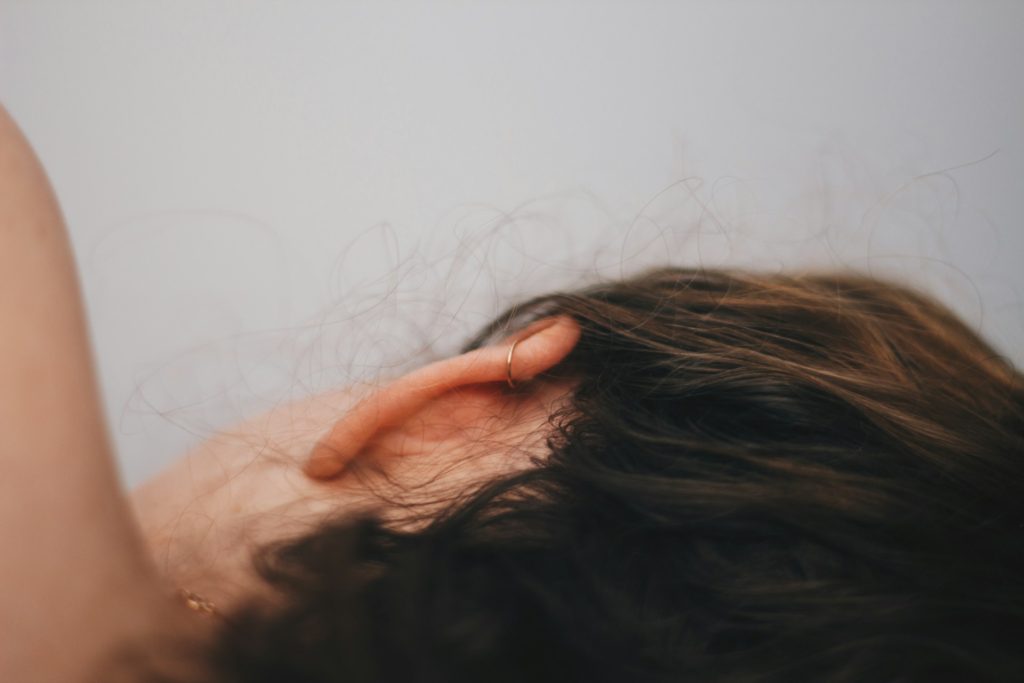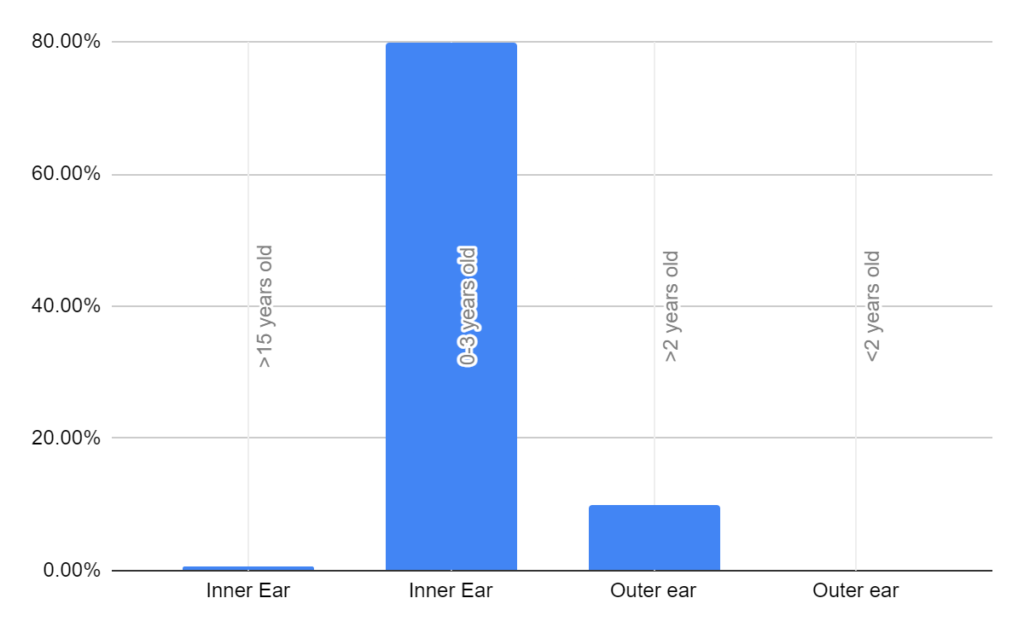
–by Dr. Peng E. Wang
Introduction
Ear pain is one of the most common symptoms that leads to doctor visits, and it’s often associated with other acute illnesses. When it comes to ear pain, it’s not always easy to determine the underlying cause, but simple questions can reveal the likely issue. We also wonder about other associated symptoms potentially contributing, such as ear pain when swallowing or sore throat on one side with ear pain. The more important questions are related to treatments. How do you relieve ear pain? When should I go to the doctor for an earache? This article discusses the common causes of earaches and how to manage them.

Overview
Common causes of earache in adults are usually due to changes in the ear canal, such as wax buildup or inflammation (otitis externa). Another common cause is pressure changes behind the eardrum, which can result from fluid buildup in the middle ear (serous otitis media). There are also less common causes, such as referred ear pain (NCBI). In the early stages of an earache, it can be hard to determine the exact cause, but answering a few questions can help you identify the cause and decide on the appropriate treatment.
- Pressure feeling without hearing loss or ear pain? pressure from the sinuses
- Pressure feeling with hearing reduction? Likely fluid behind the eardrum from sinus drainage
- Pain when pressing on the cartilage (tragus)? More likely outer ear inflammation
- Ear drainage? An outer ear infection is more likely than an inner ear issue
- Ear drainage with an ear tube placement? Consider an inner ear issue
- Sore throat and ear pain? Without a fever? Likely from sinus drainage
- Ear pain when swallowing? It is likely a eustachian tube issue due to sinus-related issues
- Fever >101F with ear pain and free of other symptoms? Please seek medical care.
The most common reasons for ear pains are either pressure behind the eardrum from sinus drainage or the pain is due to ear canal inflammation. Ask a few simple questions helps to eliminate some of the possibilities. The less common causes leading to ear pain are mostly referred to (not truly involving the ears). The referred pain is less likely to be present in the early stages of associated conditions, but you should be aware of these conditions that may be related to your earache.
In general, the treatment should be focused on identifying the underlying issue and addressing the cause of the ear pain. There are many remedies available for earache and there is a sound approach.
Common causes of earache
Eustachian tube dysfunction
Sinuses are connected with the eardrum and eustachian tubes (Wiki) because they ultimately drain toward the eustachian tube opening on the back of the nasal and oral cavity. This mechanism results in ear pressure, hearing loss, ringing (tinnitus), and pain. Many conditions lead to sinusitis, including colds, allergies, and sudden pressure changes (air travel). Useful questions to ask.
- Ear pressure, muffling sounds due to fluid behind ears?
- Congestion, runny nose, sinus pressure?
- The feverish feeling during a head cold?
- Measured temp <100F typically?
- Ear pain when swallowing?
- Postnasal drainage?
- Sore throat?
- Cough?
Related article: The Common Cold Symptoms and Treatments
Ear canal inflammation (Otitis Externa)
The other common cause of ear pain involves the ear canal (Medscape). There are many causes for this, including weather changes leading to an eczema-like reaction in the ear canal. These symptoms also occur when water enters the ear canal or if you wear earbuds or headsets for prolonged periods. Any moisture cumulating in the ear canal can break the skin breakdown and cause an outer ear infection. Useful questions to ask.
- Manipulating the ear canal opening (tragus) hurts?
- Pain radiating downward to the side of the face?
- Laying the side of the affected ear hurts?
- Does the ear feel swollen and blocked?
- Probing with a Q-tip results in pain?
- Itching inside the ear canal?
- Ear pain when swallowing?
- Rash on the earlobe?
- Reduced hearing?
Eardrum inflammation (Otitis Media)
Inner ear infections are mostly in children, it’s not common in adults. The phrase “otitis media” does not mean infection but rather inflammation of the eardrum (Medscape). However, the common cause of true middle ear inflammation is due to an infectious agent, particularly in children (Medscape). You may be asking why middle ear inflammation occurs more in children. Our theory is that the adult eustachian tube is more vertical so it drains better thus less fluid sits on the eardrum (ENTSurgery). Useful questions to ask.
- Ear pain with drainage coming out of the ear?
- The child is tugging on their ears a lot?
- Fatigue and unwell appearing?
- Fever >102F and persistent?
- Nausea and poor appetite?
- Allergies symptoms also?
- Reduced hearing?
Read more about the management of middle ear infections by the American Academy of Pediatrics (AAP).
Uncommon causes of ear pain
- TMJ (temporomandibular joint), typically from grinding or clenching
- Cellulitis (skin infection) of the ear and facial region
- Mastoiditis (a serious condition that requires immediate evaluation)
- Shingles (herpes zoster) induced Ramsey Hunt syndrome, requires immediate evaluation
- Cholesteatoma (fatty tumor on eardrum) causes ear fullness feeling
- Trauma including blunt head trauma or barotrauma (pressure)
- Infected cyst of the ear canal (very painful without drainage or hearing loss)
- Tumors (hearing loss without pain)
Although less common, these conditions describe associated symptoms that can help determine a possible cause of the abnormal ear sensations and indicate when to seek medical attention (AAFP).
Ear pain Treatments
Recommended
Supportive management
Inner ear
- Prop yourself up 30 degrees when sleeping to improve drainage
- Use a humidifier at night to improve and moisturize the sinuses
- Use steam in the shower or bath to humidity
- Ear tug to clear sinuses (YouTube)
Outer ear
- Hydrate ear canal if it’s itchy with moisturizers, yes if Q-tip needed
- Cool compresses to reduce swelling and pain
Antihistamines type 1; over-the-counter
- Claritin, the active ingredient is loratadine, with fast onset in one hour if taken on an empty stomach
- Clarinex, active ingredient is desloratadine, an analog of Claritin, has fewer side effects
- Zyrtec, active ingredient is cetirizine, with fast onset in one hour if taken on an empty stomach
- Xyzal, the active ingredient is levocetirizine, an analog of Zyrtec, with fewer side effects
Debridement; over-the-counter
- DeBrox, the active ingredient is carbamide peroxide, used as needed to clear wax
- Vosol, the active ingredient is acetic acid, useful for maintaining a healthy ear canal
Fever and pain reducer; over-the-counter
- Tylenol, active ingredient is acetaminophen, 500mg or 325mg, use as needed
Moisturizers (emollients)
- E-Oil, the active ingredient is vitamin E in oil form
- Vite-E Creme, the active ingredient is vitamin E in cream form
- Coppertone Aftersun Lotion (vitamin E)
Nasal steroid topicals; over-the-counter; as needed
- Flonase, the active ingredient is fluticasone propionate, slow onset, alcohol-based solution
- Nasacort, the active ingredient is mometasone, slow onset, non-alcohol based solution (less likely to cause nosebleed)
Non-steroid Anti-inflammatory Drugs (NSAID); best to be scheduled
Topical antibiotics (prescription)
- Cortisporin Otic, the active ingredients are hydrocortisone/neomycin/polymyxin
- Cipro HC Otic, the active ingredients are hydrocortisone/ciprofloxacin, use if ear tube in place
Do not recommend
Over-the-counter cold remedies
- Dayquil, active ingredients include phenylephrine and guaifenesin
- Mucinex Cold/Flu, active ingredients include phenylephrine, a decongestant
- Any packaging that states “Cold and Sinus” and “Cold and Flu”
Mucus relief (expectorants)
- Mucinex, the active ingredient is guaifenesin, also in Robitussin and many cold medicines
- Mucinex Children’s Stuffy Nose
- Mucinex Sinus-Max Clear & Cool
Decongestants (Hides well in many remedies, look at the ingredients)
- Afrin nasal spray, the active ingredient is oxymetazoline
- QlearQuil 12-Hour Nasal Decongestant Moisturizing Spray
- Vicks Sinex 12-Hour
- Vicks Sinex Severe Decongest
- Mucinex Children’s Stuffy Nose
- Mucinex Sinus-Max Clear & Cool
- Dayquil, active ingredients include phenylephrine
Behind the counter
- Claritin-D, active ingredients are loratadine and pseudoephedrine
- Zyrtec-D, active ingredients are cetirizine and pseudoephedrine
- Allegra-D, active ingredients are fexofenadine and pseudoephedrine
- Mucinex-D, active ingredients are guaifenesin and pseudoephedrine
Complications and prevention
When to see a doctor (urgent)
- Dental pains
- Persistent fever >102F
- Facial droop (Bell’s Palsy)
- Severe ear pain with drainage
- Nausea and dizziness passing out sensations
- Chest pains and shortness of breath (heart attack)
- Pain behind the ear on the bone and swelling or fever (mastoiditis)
- Temple pain on the same side with vision changes (Temporal arteritis)
- Gradual hearing loss, ringing, ear fullness, dizziness, facial numbness, and weakness (suspect tumor)
- One-sided hearing loss with a rash and pain on the same side (Shingles complication, Ramsay Hunt Syndrome)
Prevention
- Wear ear protection when diving and swimming
- Avoid using decongestants for sinuses
- Wear ear protection for loud sound
- Hydrate ear canals if have eczema
- Clear wax out
Conclusion:
While it is impossible to cover all potential reasons for an earache in this article, there are patterns to be recognized to optimize its management. Most importantly, we need to understand that earaches in adults are mostly referred pains and we need to focus on treating the underlying issue. The primary ear pains in adults are mostly due to pressure behind the eardrums from sinuses or ear canal inflammation. By reviewing the above symptom patterns and management, you should have a sound approach for an earache, especially when you should be seeing a provider in person for an ear scope.
Bonus: Antibiotic Eardrops
Can antibiotic eardrops help in cases of earache? The short answer is yes. Antibiotics typically are non-selective, meaning they reduce all microbes. While it’s not generally recommended for the common cold since it’s difficult to tell the difference between viral and bacterial, the argument here is that the result at the tissue level is the same: inflammation. See antibiotics as an indirect anti-inflammatory. Reducing the microbial burden on inflamed tissue reduces symptoms and transmission. This argument is sound for topical antibiotics only, not systemic (oral) antibiotics unless AOM is suspected. Since antibiotics are non-selective, they will reduce the good microbes in your airway, gastrointestinal tract, and urinary system when taken orally; this puts you at risk for other infections.

Related article: The Common Cold Symptoms and Treatments